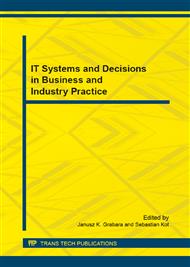p.149
p.157
p.165
p.171
p.179
p.186
p.194
p.201
p.209
ERP – Specific Form of Integrated Applications
Abstract:
The integrated ERP system includes in a unitary whole that is performed in an enterprise, production, distribution, accounting, finance, stocks, service and maintenance, logistics and provides information accessibility, visibility and consistency for the entire enterprise. The ERP system enables the integration of all information applications into a global information solution, occupying all organizational elements in an enterprise, which are in a close mutual interdependency. Thus, the delimitations between the departments and divisions of the enterprise, including those between the enterprise and its environment are removed, thus providing the enterprise with multiuser, multipurpose and multispace working possibilities. The main purpose of this article is to present the very wide and deep overview of ERP systems, together with its applications, structure, opinions and algorithms of ERP functioning.
Info:
Periodical:
Pages:
179-185
Citation:
Online since:
October 2015
Authors:
Price:
Сopyright:
© 2015 Trans Tech Publications Ltd. All Rights Reserved
Share:
Citation:


